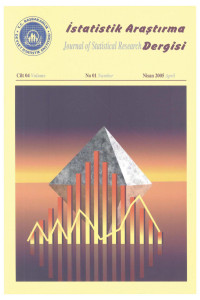Konjoint Model Uygunluğu Üzerinde Değişken Etkilerinin Sınıflama Regresyon Ağaçları Analizi ile İncelenmesi
Abstract
Konjoint analizi daha çok pazarlama araştırmalarında tüketici tercihlerinin belirlenmesinde kullanılan çok değişkenli istatistiksel bir yöntemdir. Konjoint Analizi'nin en önemli özelliği ise, nitelikleri nicel olarak karşılaştırmasıdır.
Konjoint Analizinde kurulan model ile anket yapılan kişilerin verdikleri cevaplar arasındaki uygunluk, modelinin yapısına göre Pearson'un R ya da Kendall’ın Tau katsayısı ile değerlendirilir.
Sınıflama regresyon ağacı (Classification Regression Trees C&RT) analizi ile bağımlı değişken üzerinde etkili olan değişkenler homojen gruplara ayrılarak belirlenirler.
Bu çalışmada daha önce yapılmış Konjoint Analizi üzerine bir çalışma sonucunda her bir birey için elde edilen sonuçlar yeniden değerlendirilmiş ve her bir birey için elde edilen korelasyon katsayısı düşük, orta ve yüksek olmak üzere üç kategoriye ayrılmış ve ele alınan diğer değişkenlerin oransal önemlerinin korelasyon katsayısı üzerindeki etkileri C&RT analizi ile belirlenmeye çalışılmıştır.
Keywords
References
- ANSWER TREE 1.0 (1998), Users Guide, SPSS Inc., P, 169-170
- HAIR, J.F., ANDERSON, R.E., TATHAM, R.L., BLOCK, W.C., (1995), Multivariate Data Analysis with Readings, McMillan Book Company, London.
- DIJKSTRA, J., ve TlMMERMANS, H.J.P., (1997), Exploring the Possibilities of Conjoint Measurement as a Decision-Making Tool for Virtual Way finding Environments, Hu's Publishers Inc., Taipeh, p61.
- SARAÇLI, S. (2004), Müşteri Tercihlerinin Araştırılmasında Konjoint Analizi ve Bireysel Emeklilik Sistemi Üzerine Bir Uygulama, Yüksek Lisans Tezi, Anadolu Üniversitesi, Eskişehir.
- SÖNMEZ, H. (2001), Konjount Analizi Tekniğinin Pazarlama Araştırmalarında Kullanım Olanakları ve Bir Uygulama, Doktora Tezi, Anadolu Üniversitesi, Eskişehir.
- ŞIKLAR, E., YILMAZ, V., SARAÇLI , S., (2004), Tüketicilerin Alışveriş Merkezi Tercihinin Konjount Analizi ile İncelenmesi, Dokuz Eylül Üniversitesi, İstatistik Günleri Sempozyumu, Kuşadası.
- AHOLA, J., RINTA-RUNSALA, E., (2001), Data Mining Case Studies in Customer Profiling, VTT Information Technology, Research Report, TTE1-2001-29. Erişim:http://www.vtt.fi/datamining/publications/dm_case_studies.pdf; Erişim Tarihi: 28.09.2004.
- STATSOFT INC. (2003), Classification and Regression Trees (C&.RT), Copyright 1984-2003, (Erişim: http://www.statsoftinc.com/textbook/stcart.html#overview, Erişim Tarihi: 07.07.2004).
Examining the Effects of the Variables on Conjoint Model Fitness with Cert (Classification&Regression Trees) Analysis
Abstract
Conjoint Analysis is a multivariable statistical analysis that is generally used in marketing researches to put forward the consumer's preferences. The most important feature of Conjoint Analaysis is the ability of comparing the qualities as quantitives.
In Conjoint Analysis, the fitness between the Konjoint model and the answers of the responders is evaluated with Pearson's R coefficient or Kendall's Tau coefficient by the type of the model.
In C&RT (Classification Regression Trees) analysis the effects of the independent variables on dependent variable are determined by separating these variables in to homogeny two subgroups.
In this study, the results of an other study named "Examining the Consumers shopping center preferences with Conjoint Analysis”, are taken as an input data and the correlation coefficient, calculated for each responder, is categorized as low, medium and high and the effects of the averaged importance of the independent variables on this coefficient is tried to put forward with C&RT analysis.
Keywords
References
- ANSWER TREE 1.0 (1998), Users Guide, SPSS Inc., P, 169-170
- HAIR, J.F., ANDERSON, R.E., TATHAM, R.L., BLOCK, W.C., (1995), Multivariate Data Analysis with Readings, McMillan Book Company, London.
- DIJKSTRA, J., ve TlMMERMANS, H.J.P., (1997), Exploring the Possibilities of Conjoint Measurement as a Decision-Making Tool for Virtual Way finding Environments, Hu's Publishers Inc., Taipeh, p61.
- SARAÇLI, S. (2004), Müşteri Tercihlerinin Araştırılmasında Konjoint Analizi ve Bireysel Emeklilik Sistemi Üzerine Bir Uygulama, Yüksek Lisans Tezi, Anadolu Üniversitesi, Eskişehir.
- SÖNMEZ, H. (2001), Konjount Analizi Tekniğinin Pazarlama Araştırmalarında Kullanım Olanakları ve Bir Uygulama, Doktora Tezi, Anadolu Üniversitesi, Eskişehir.
- ŞIKLAR, E., YILMAZ, V., SARAÇLI , S., (2004), Tüketicilerin Alışveriş Merkezi Tercihinin Konjount Analizi ile İncelenmesi, Dokuz Eylül Üniversitesi, İstatistik Günleri Sempozyumu, Kuşadası.
- AHOLA, J., RINTA-RUNSALA, E., (2001), Data Mining Case Studies in Customer Profiling, VTT Information Technology, Research Report, TTE1-2001-29. Erişim:http://www.vtt.fi/datamining/publications/dm_case_studies.pdf; Erişim Tarihi: 28.09.2004.
- STATSOFT INC. (2003), Classification and Regression Trees (C&.RT), Copyright 1984-2003, (Erişim: http://www.statsoftinc.com/textbook/stcart.html#overview, Erişim Tarihi: 07.07.2004).
Details
| Primary Language | Turkish |
|---|---|
| Subjects | Statistics |
| Journal Section | Research Articles |
| Authors | |
| Publication Date | April 15, 2005 |
| Published in Issue | Year 2005 Volume: 4 Issue: 1 |

